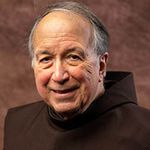Saint Margaret of Cortona: Lay Franciscan Penitent

On May 16, the Franciscan family celebrates the life of a lay Franciscan penitent, St. Margaret of Cortona (1247–1297).
Escaping home
Margaret was born into a farming family in the small village of Laviano in the diocese of Chiusi, Italy. Her mother died when Margaret was seven and her father remarried; the relationship between Margaret and her stepmother was not good, so Margaret, a beautiful, high-spirited girl, ran off when she was 18, and went to work for a nobleman who lived near Montepulciano. They entered into a relationship and had a son.

A dossal of Margaret, painted the year after her death, similar to the dossal of Saint Clare in Assisi, with scenes from her life surrounding the central figure.
Forced with her child to leave her home
Nine years later, when she was 27, her partner’s faithful dog came home alone, went directly to Margaret’s room, and began whining. Margaret followed the dog into the woods and discovered her lover’s murdered body. With no legal standing, she and her child were forced to leave her home; she attempted to return to her family in Laviano, but they refused to take her in.
Working as midwife
Ultimately, Margaret sought refuge in the Tuscan hill town of Cortona where she engaged in penitential practices and worked as a midwife to support herself and her son. There, in 1277, despite malicious gossip because of her former life, she joined the Brothers and Sisters of Penance (“Third Order” Franciscans) associated with the church of the Friars Minor.
Forming group of women dedicated to care of sick, poor, and homeless
Margaret began dedicating herself to the care of the sick, poor, and homeless, eventually forming a group of women to join her in this task. Margaret was far from a “shrinking violet”; she had a forceful personality and did not hesitate to speak out as a moral conscience for her city, even chastising the local bishop.
The third light given to the Order
According to a vision she related to her friar confessor, Christ had told her, “You, Margaret, are the third light given to the Order of my blessed Francis. The first light (Francis) is in the order of Friars Minor; the second is the blessed Clare in the order of Sisters. The third, in the order of penitents, is you.”

Margaret in ecstasy before the crucifix, Giovanni Battista Piazzetta, 1737, National Gallery of Art, Washington
Serving as spiritual mentor
Toward the end of her life, Margaret retired to a small chapel on the hill above Cortona, where she devoted herself to prayer, serving as a spiritual mentor to many people until her death, February 22, 1297. Margaret was venerated by the people of Cortona as a saint from the time of her death, although she was not officially canonized until 1728. She is venerated as the patroness of single mothers, people falsely accused, and homeless people. Her day is observed as a feast by Secular Franciscans and the Third Order Regular and as a memorial among the Friars Minor and the Poor Clares.

The basilica of St. Margherita in Cortona, built on the site of the hermitage/chapel of St. Basil, where she spent her final years.
Learn more
There is an excellent brief account of Saint Margaret’s fascinating life in Dr. Darleen Pryds’ study, Women of the Streets: Early Franciscan Women and their Mendicant Vocation, which provides an introduction to several early Franciscan penitent women.

Saint Margaret's remains are enshrined in the basilica named after her in Cortona.
-----
Main image: Detail from a dossal of Saint Margaret, painted the year following her death (1297)
Dominic Monti, OFM
Professor of Franciscan Research in the Franciscan Institute of St. Bonaventure University
Dominic V. Monti, OFM, is a Franciscan Friar of Holy Name Province (USA) and currently professor of Franciscan Research in the Franciscan Institute of St. Bonaventure University. He devoted the greater part of his ministry to teaching the History of Christianity, in particular the history of the Franciscan movement. He has contributed two volumes to the Works of St. Bonaventure series and is author of Francis & His Brothers, a popular history of the Friars Minor.

